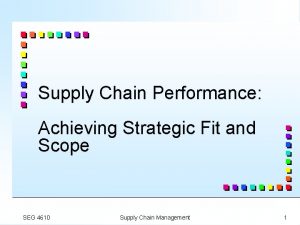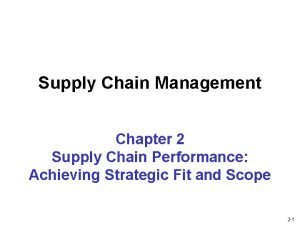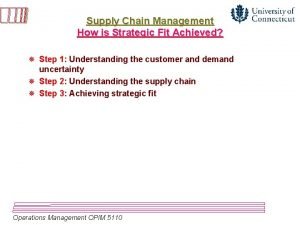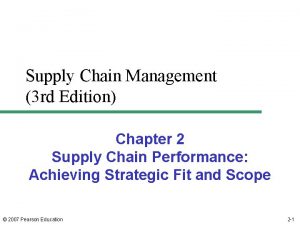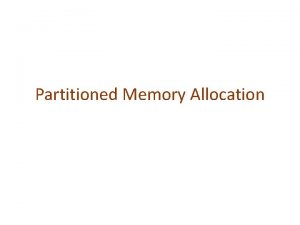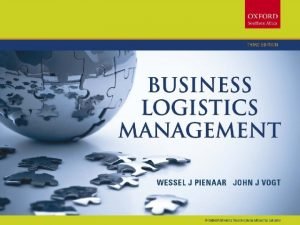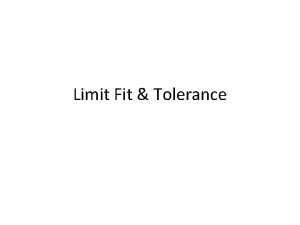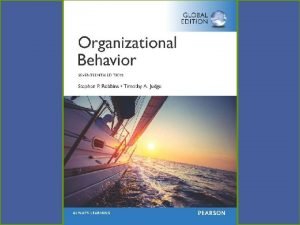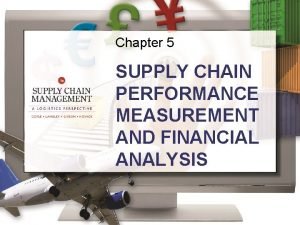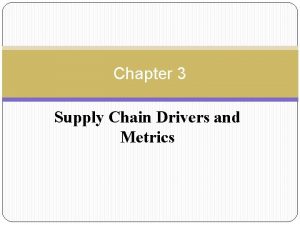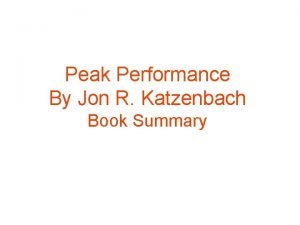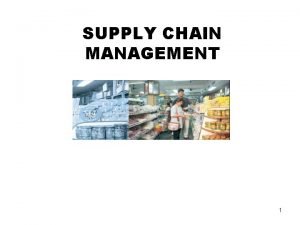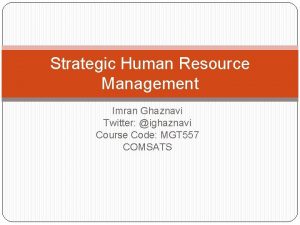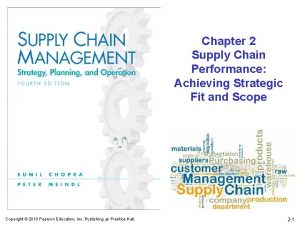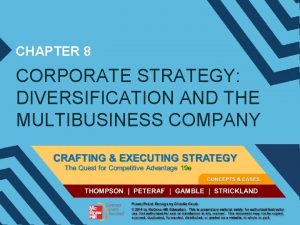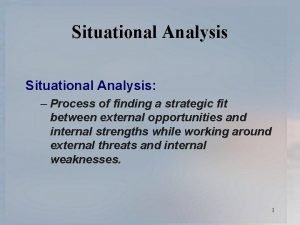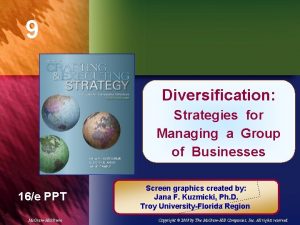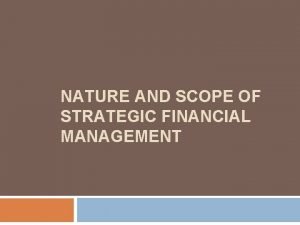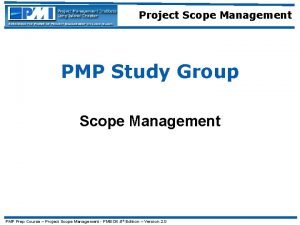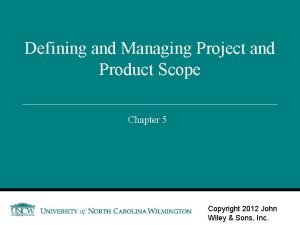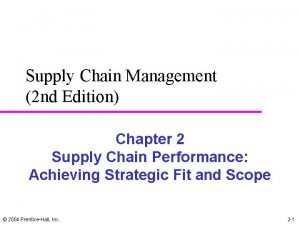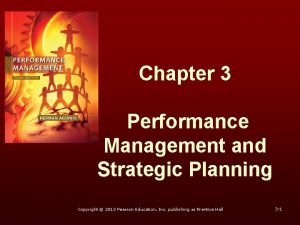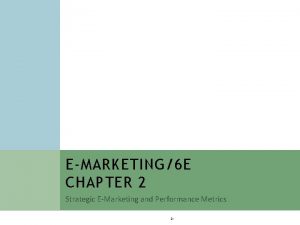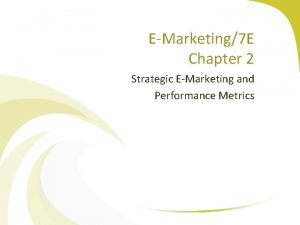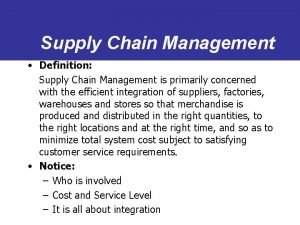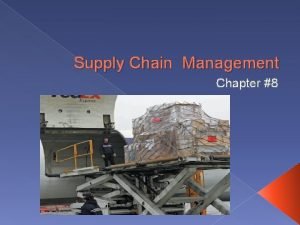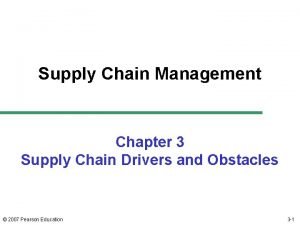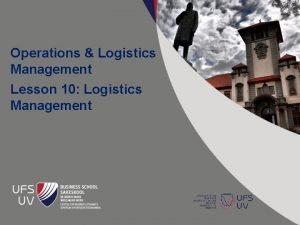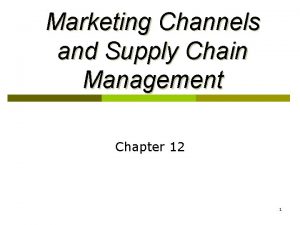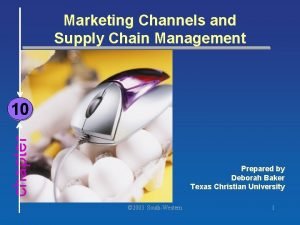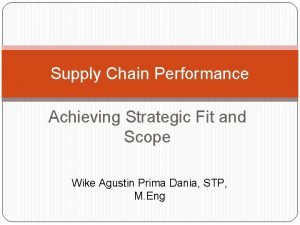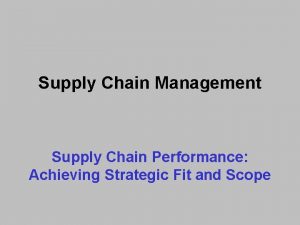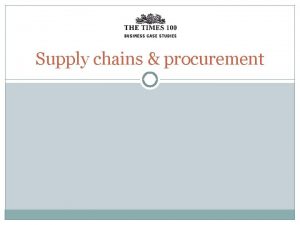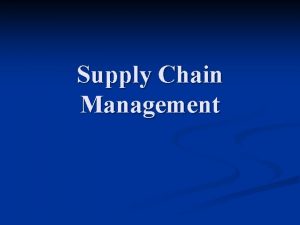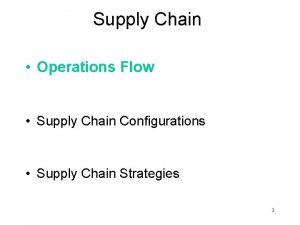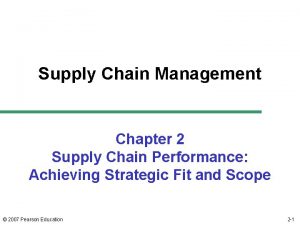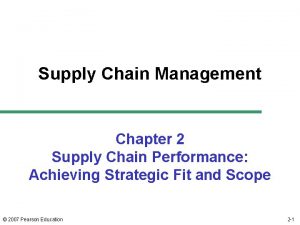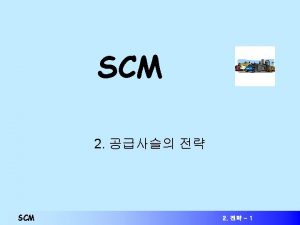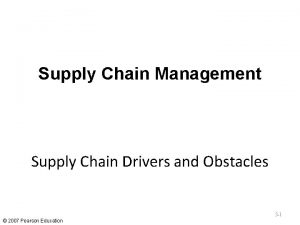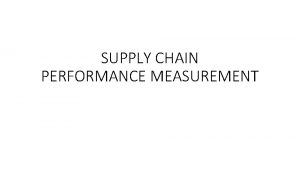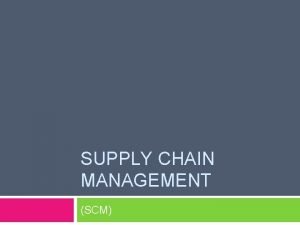Supply Chain Performance Achieving Strategic Fit and Scope








































- Slides: 40

Supply Chain Performance: Achieving Strategic Fit and Scope SEG 4610 Supply Chain Management 1

Strategic Decisions § Strategic Decisions are ones that keep an organisation matched to its environment. § Motivation: n Assure long term survival n Ensure profit growth SEG 4610 Supply Chain Management 2

The Value Chain in a company Finance, accounting, Info Technologies, human resources New Product Development Marketing and Sales Operations Distribution Service Supply Chain Strategy SEG 4610 Supply Chain Management 3

Competitive Strategy A company’s competitive strategy defines the set of customer needs that it seeks to satisfy through its products and services. n n Compaq (immediate availability) vs. Dell (customisation) Park’N’Shop vs. Citi. Super § Based on the customers’ priorities § Targets one or more customer segments § Aim: provide goods/services to satisfy these customers’ needs SEG 4610 Supply Chain Management 4

Competitive Dimensions § § Cost Quality Time Flexibility/Variety § Strategic Positioning n Defines those positions that a firm wants to occupy in the competitive product space. SEG 4610 Supply Chain Management 5

Corporate Strategy, Competitive Priorities and Functional Inter-relationships Market analysis • segmentation • needs assessment Socioeconomic and business environment Corporate strategy • missions • goals • distinctive Future directions • global strategy • new products/services Competitive priorities • cost • quality • time • flexibility Capabilities • current • needed • plans Functional area strategies SEG 4610 Supply Chain Management 6

Terry Hill (London Business School): Order Winners & Qualifiers Order Qualifiers are those (minimum) criteria that a company must meet to be considered as a possible supplier (e. g. ISO 9000). n Order winners are those criteria that wins the orders. n n Invariably due to re-directing competitive priorities SEG 4610 Supply Chain Management 7

Functional Strategies n Product development § Product portfolio? Outsourced or internal development? n Marketing § Customer segments? Products/price/promotion? Competitors? n Finance § Acquisition and allocation of resources n Supply Chain § Procurement, production, delivery and service SEG 4610 Supply Chain Management 8

Developing an Operations Strategy (Terry Hill) 1. Define corporate objectives. 2. Determine marketing strategies (strategic positioning). 3. Assess how different products qualify in their respective markets and win orders against competitors. 4. Establish appropriate operational processes for product manufacture and delivery. 5. Provide the operational infrastructure to support production/delivery. SEG 4610 Supply Chain Management 9

Strategic Fit Strategic fit means consistency between the competitive advantage that a firm seeks and the process capabilities and managerial policies that it uses to achieve that advantage. n Key to success: n n Competitive strategy and functional strategies must support each other and fit as a co-ordinated overall strategy. Each function must structure its processes to be able to execute these strategies well. SEG 4610 Supply Chain Management 10

Achieving Strategic Fit 1. Understand the customer § § 2. Understand the supply chain § § 3. Customer needs for targeted segments? Define service requirements and desired costs Operational characteristics Performance vs. customer needs Achieving strategic fit § § SEG 4610 Re-structure supply chain Alter competitive strategy Supply Chain Management 11

Understanding the customer § § § Lot size Response time Service level Product variety Price Innovation SEG 4610 Supply Chain Management 12

Implied vs. “real” demand uncertainty § Implied demand uncertainty is the uncertainty that exists due to the portion of demand that the supply chain is required to meet. § Affected by: § Portion of demand (Market segment) handled by supply chain § Attributes desired by customers SEG 4610 Supply Chain Management 13

Implied Uncertainty Spectrum Low Implied Demand Uncertainty Purely functional products Gasoline SEG 4610 Somewhat Certain Demand Somewhat Uncertain Demand High Implied Demand Uncertainty Established products New models of existing goods Entirely new products Crest toothpaste New Ford Taurus Palm Pilot Supply Chain Management 14

Relationship between Demand Characteristics and Implied Demand Uncertainty (Fisher) Attribute Low Implied Uncertainty High Implied Uncertainty Profit margin Low High Average forecast error 10% 40% to 100% Average stockout rate 1% to 2% 10% to 40% Average forced end-of-season markdown 0% 10% to 25% SEG 4610 Supply Chain Management 15

Achieving Strategic Fit 1. Understand the customer § Map where their demand is located on the implied uncertainty spectrum 2. 3. Understand the supply chain Achieving strategic fit SEG 4610 Supply Chain Management 16

Understanding the Supply Chain § Supply chain responsiveness is its ability to: § § § Respond to wide range of quantities demanded Meet short lead times Manufacture large variety of products Meet high service level Innovate – anticipate customers’ demand § Responsiveness comes at a cost … SEG 4610 Supply Chain Management 17

Understanding the Supply Chain § Supply chain efficiency is the cost of making and delivering a product to the customer. § Responsiveness – cost efficient frontier § Tradeoff between cost efficiency and responsiveness => § Supply chain strategy -> level of responsiveness offered SEG 4610 Supply Chain Management 18

Responsiveness Spectrum Highly efficient Advance production schedule; low variety or flexibility Glass production SEG 4610 Somewhat efficient Somewhat Responsive Highly responsive Make-tostock; Long production lead time (months) Mix model production; Production lead time in weeks Make-toorder; Lead time in days M&S underwear Automobile production Dell PC Supply Chain Management 19

Achieving Strategic Fit 1. Understand the customer § Map where their demand is located on the implied uncertainty spectrum 2. Understand the supply chain § Map where the supply chain capability is located on the responsiveness spectrum 3. Achieving strategic fit SEG 4610 Supply Chain Management 20

Achieving Strategic Fit Responsive Supply Chain Efficient Supply Chain Certain demand SEG 4610 Supply Chain Management Uncertain demand 21

Efficient vs. Responsive Supply Chains Strategy Efficient Supply Chains Responsive Supply Chains Primary goal Meet (predictable) demand at low cost Respond quickly to demand Product design Max performance at min cost Flexible design (modularity, mix-&-match) Pricing Lower margin Higher margin Manufacturing High facility utilisation (low average cost) Capacity flexibility and cushion Inventory Minimise inventory levels Maintain buffer inventory to meet unexpected demand Lead Time Reduce, but not at the expense of production costs Aggressively reduce Supplier Select based on cost and quality Select based on speed, flexibility and quality Transportation Low costs modes Responsive and speedy modes SEG 4610 Supply Chain Management 22

Achieving Strategic Fit 1. Understand the customer § Map where their demand is located on the implied uncertainty spectrum 2. Understand the supply chain § Map where the supply chain capability is located on the responsiveness spectrum 3. Achieving strategic fit § Match supply chain responsiveness to implied demand uncertainty in zone of strategic fit. § Other functional strategies must also be coordinated. SEG 4610 Supply Chain Management 23

Outputs of Strategy (Terry Hill) n n Review of implications for manufacturing processes and infrastructure support for current and future products Assess degree of match between capabilities and order-winning and order-qualifying needs Continual monitor changes in match and mismatch Necessary operational re-design, infrastructure investments, change schedule integrated into corporate strategy in coordination with other functional strategies SEG 4610 Supply Chain Management 24

§ There is no SINGLE right supply chain for everyone … § There is only a right supply chain for your given competitive strategic position. SEG 4610 Supply Chain Management 25

Other issues affecting Strategic Fit § Company offers multiple products to different customer segments § Grainger: machine parts to Boeing, Ford and also small manufacturers § Fast-moving products warehouses dispersed; slow moving items stored centrally § Product life cycles § Demand characteristics different at different stages of life cycle § Competitive strategic positioning will also change § Supply chain and other functional strategies must adapt as product enters different stages of its life cycle § Competitors’ actions change over time § New products/services § Customers’ expectations changes SEG 4610 Supply Chain Management 26

Strategic Scope Suppliers Manufacturers Distributors Retailers Customers Competitive Strategy Product Development Strategy Supply Chain Strategy Marketing Strategy SEG 4610 Supply Chain Management 27

Expanding Strategic Scope § Intra-company intra-operations scope: minimize local costs § Intra-company intra-functional scope: minimize functional costs § Intra-company inter-functional scope: Maximize company profits § Inter-company inter-functional scope: Maximize supply chain surplus § The inter-company view essential as competition is not company vs company , but supply chain vs supply chain § The broader inter-company scope increases the size of the surplus to be shared among all stages of the supply chain SEG 4610 Supply Chain Management 28

Drivers of Supply Chain Performance n n inventory transportation facilities information n Efficiency Responsiveness impact on supply chain performance role in competitive strategy decision components SEG 4610 Supply Chain Management 29

Inventory n n n Present throughout the supply chain: Raw materials, work-inprocess, finished goods at manufacturers/distributors/retailers, etc. Supply Chain role: n Inventory reflects a mismatch of supply and demand n Purposeful: economies-of-scale, anticipate future demand n Related to throughput and “flow time” Competitive Strategy role: n n n location and amount of finished goods inventory impacts product availability (responsiveness) centralised/distributed storage impacts costs Decision Components: n n n cycle inventory : inventory to meet demand between shipments safety stock: inventory held to meet unexpected demand seasonal inventory: inventory to meet predictably variable demand SEG 4610 Supply Chain Management 30

Transportation n Supply Chain role: n Moves product between different stages in a supply chain n Faster transportation modes decreases “flow time” Competitive Strategy role: n More frequent deliveries increases responsiveness n Transportation system structure and operation must match the efficiency-responsiveness balance to competitive strategic position Decision Components: n Transportation mode: n n n air, truck, rail, ship, pipeline, Electronic delivery Network design and route selection In-house or out-source SEG 4610 Supply Chain Management 31

Facilities n Supply Chain role: n Locations where “value-added” takes place in a supply chain n n Manufacturing (transformation), Warehousing (storage) Competitive Strategy role: n Number and dispersion of warehouses affects costs n facilities, management, inventory, transportation Location proximity to customers affects responsiveness n Global and local presence affects customers’ perception Decision Components: n Location n Capacity n Manufacturing Structure (Process Choices) n Warehousing Operations n n SEG 4610 storage by SKU or job-lots cross-docking Supply Chain Management 32

Information n n Supply Chain role: n Information connects the various stages of a supply chain n Daily operational decisions based on information about forecasted demand product availability Competitive Strategy role: n New info channels (e. g. Internet B 2 B platforms) allow customers to design their customised products (increases responsiveness) n Data collection increases understanding of customers’ preference n n n target market segments improves demand forecasts Decision Components: n Choice of enabling technologies n n EDI, Internet, ERP (SCM) software Push vs pull supply chains impacts info system design Co-ordination and information sharing Forecasting SEG 4610 Supply Chain Management 33

Major Obstacles to Achieving Fit n Multiple owners and/or incentives in a supply chain n n Customer fragmentation n n n Local optimisation and lack of global fit Increased product variety Shortening life-cycles Increasingly demanding customers Increasing implied demand uncertainty Higher service expectations Globalisation n Complexity of supply chain Increased competition Increased difficulty in executing new strategies SEG 4610 Supply Chain Management 34

Dealing with obstacles n Multiple owners n n n Customer fragmentation n Contractual co-ordination Information co-ordination Mass customisation Tailored logistics Globalisation n Global companies, strategic partnerships First-mover advantage Company culture, investment in human resources SEG 4610 Supply Chain Management 35

E-Commerce Strategy What is E-commerce? Commerce transacted over the Internet n n Product information n Order placement and/or negotiation n Order tracking n Order fulfilment n Payment SEG 4610 Supply Chain Management 36

Revenue Impact of E-Commerce Length of supply chain n Product Info n Time to market n Price/Contract Negotiation n Order placement and tracking n Order fulfilment n Payment n SEG 4610 Supply Chain Management 37

Cost Impact of E-Commerce n Facility n n Inventory n n Levels and kinds Transportation n n Site and processing costs Inbound/out bound logistics Infrastructure n n Information Sharing Co-ordination SEG 4610 Supply Chain Management 38

Summary n Competitive Strategic Positioning n n Supply Chain Performance n n n Efficiency vs Responsiveness Co-ordinated strategies Strategic Fit n n Order-winners and qualifiers customers: implied demand uncertainty spectrum supply chain: responsiveness-cost spectrum Challenges E-commerce SEG 4610 Supply Chain Management 39

References Fisher, M. L. , ‘What is the right supply chain for your product? ’, Harvard Business Review, Mar-Apr 1997. Marien, E. J. , ‘The four supply chain enablers’, Supply Chain Management Review, Mar-Apr, 2000, 60 -68. Hill, T. , Manufacturing Operations Strategy: Text and Cases, Mc. Graw-Hill, 2009. SEG 4610 Supply Chain Management 40
 Implied uncertainty spectrum
Implied uncertainty spectrum Supply chain performance achieving strategic fit and scope
Supply chain performance achieving strategic fit and scope Implied demand uncertainty
Implied demand uncertainty First fit next fit best fit worst fit
First fit next fit best fit worst fit Implied demand uncertainty in supply chain management
Implied demand uncertainty in supply chain management Memory allocation policy
Memory allocation policy Strategic fit vs strategic intent
Strategic fit vs strategic intent Matching supply and demand in supply chain
Matching supply and demand in supply chain What is logistics management
What is logistics management Logistics vision statement examples
Logistics vision statement examples Clearance fit and interference fit
Clearance fit and interference fit Person-job fit and person-organization fit
Person-job fit and person-organization fit Financial measures of supply chain performance
Financial measures of supply chain performance Supply chain drivers definition
Supply chain drivers definition Eltonian pyramid
Eltonian pyramid Peak performance book summary
Peak performance book summary Supply chain upstream and downstream
Supply chain upstream and downstream Twitter
Twitter Strategic fit
Strategic fit Strategic fit means
Strategic fit means A strategy of diversifying into unrelated businesses
A strategy of diversifying into unrelated businesses Strategic fit test
Strategic fit test Retrenching to a narrower diversification base:
Retrenching to a narrower diversification base: Nature and scope of strategic management
Nature and scope of strategic management Strategic complements
Strategic complements Strategic management and strategic competitiveness
Strategic management and strategic competitiveness Analysing the 6 strategic options megxit
Analysing the 6 strategic options megxit Process scope definition
Process scope definition Io2br3
Io2br3 Chapter 5 section 1 supply and the law of supply
Chapter 5 section 1 supply and the law of supply Intercompany scope
Intercompany scope Performance management and strategic planning
Performance management and strategic planning Chapter 2
Chapter 2 Strategic e-marketing and performance metrics
Strategic e-marketing and performance metrics Supply chain management meaning and definition
Supply chain management meaning and definition Order promising module of supply chain management
Order promising module of supply chain management Drivers for lean supply chain
Drivers for lean supply chain Logistics management introduction
Logistics management introduction Conventional marketing system
Conventional marketing system Marketing channels and supply chain management
Marketing channels and supply chain management Crm supply chain
Crm supply chain
